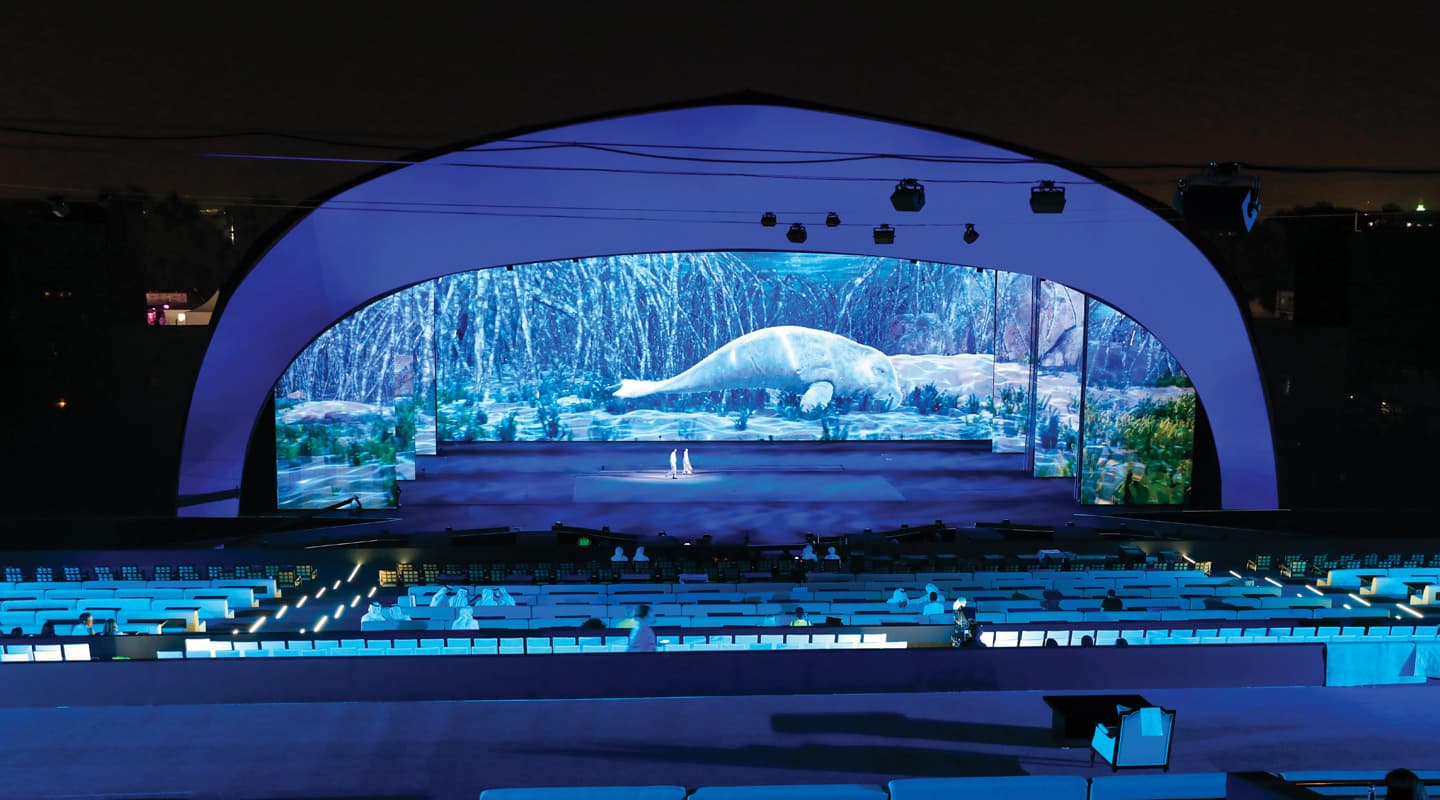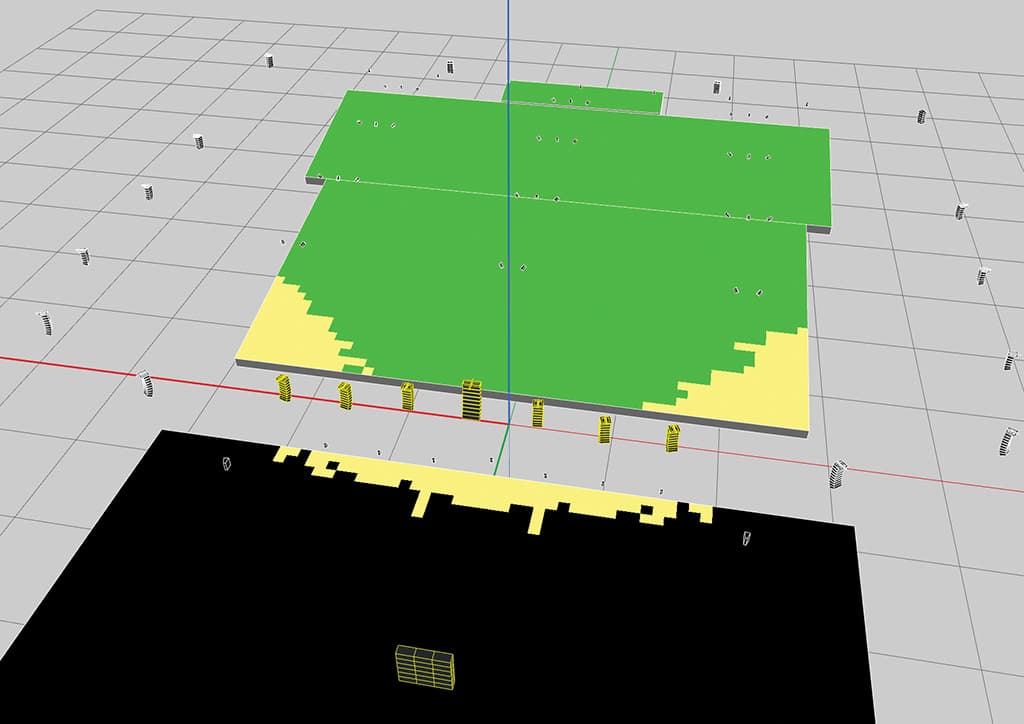
Well Oiled Machine
No expense spared, one-off event in the UAE.
Text:/ Christopher Holder
The UAE celebrates its National Day (when a bunch of Gulf States unified to create the UAE) with a variety of cultural events, military parades, and unimaginable quantities of fireworks.
A formal VIP presentation at the most recent 46th National Day last December switched things up a bit. 1800 dignitaries were treated to a no-expense-spared rich-media manifesto of UAE as a leader in the world of hi-tech and an ambitious vision-cast of the future. An enormous (40m wide by 14m high) stage was replete with LED and projections and the listening area was surrounded by a L-Acoustics L-ISA-controlled PA. It was a fully immersive experience for those present, both visually and aurally, and masterminded by UK event producers, Done+Dusted.
Auditoria director, Scott Willsallen, got the call to take care of the audio design. He knew it had to be ambitious; state of the art; and at the very least in surround, if not totally in the 360 with overheads.
COMPARING SYSTEMS
AV Asia Pacific: When you were considering your options in the lead up to the UAE event, how did you arrive at L-ISA as the preferred option?
SWA: We did a lot of work for the Sydney Opera House when they recently upgraded the Joan Sutherland Theatre with a d&b Soundscape system. We helped them by creating an evaluation environment so they could more easily shortlist the available options — that way we could more easily switch between them and give the manufacturers different tasks to perform so they could show us their strengths and weaknesses.
Going into this UAE event, the platform I was least familiar with was L-ISA, mainly because it hadn’t been released in the field and there was only one location in London where you could really evaluate it. I spent a few weeks in London in August last year to try and get a really good understanding of it: how it worked, how to operate it, the things it does well, the things it does less well and things they’re planning on improving.
At that point it was clear that L-ISA was my preferred option in terms of the user interface, and these things are almost entirely about the user interface. They all have to sound good but they all do. So really it’s about how well you can control it and manipulate it.


SPACE & REVERB
AV Asia Pacific: Where a system like L-ISA is more than a powerful matrix router is in its ability to provide artificial ambience to introduce ‘distance’ or space into a mix. How does L-ISA perform in this regard?
SWA: The current reverb engine within L-ISA is simplistic — not just simplistic from the point of view of how it sounds, it’s simplistic from how can be implemented within a show.
Where they’re heading is much more exciting, both from what the reverb sounds like in the time domain and in the frequency domain but also how it can be used and implemented.
Introducing reverb has its pitfalls. You can very quickly end up in a situation where the sides speakers are much closer to most listeners than the main system. What you shouldn’t ever do is hear the reverberation before the direct sound. So the system needs to be aware of where the loudspeakers are and how the sound propagates through the room, ensuring there is no situation that can exist where the reverb arrives before the direct sound. That’s something that will soon be implemented.
DO’S & DON’TS: SUBS
Do consolidate your subs: “Subs being mono blocked is something we’ve been doing since 2006. So rather than being clever with subs by putting them left, right and centre in some kind of horizontal line source, tapering it and then beam steering it… rather than doing all that, if it can place them in one spot and have enough energy there, it’s always going to deliver a better result. We had our subs stacked behind the LED display — which wasn’t a solid surface. That worked really, really well for us.”
Don’t space your arrays too far apart: “We put the the main seven loudspeaker arrays above the stage no further than 15° apart to ensure smooth panning. They were about five metres apart in our case. Because of the stage height they were higher than we’d like. So we implemented front fill that pulled the image down for those at the front.”
PREPARING YOUR SOURCE MATERIAL
The soundtrack to the event was a combination of a full orchestral program (recorded at Air Studios London) along with traditional instruments and percussion. The intent is for the music program to be immersive; to transport those at the event into an amazing-sounding concert hall. From there, sound design and SFX moments would punctuate the program with creative use of the surround channels. It was a mouth watering prospect but intimidating for Scott Willsallen and his team.
SWA: The loudspeaker system side of an event like this is relatively straightforward. It’s a lot of effort to install but the design side of it is really not that complicated. The complicated aspect was in the production workflow; that’s a complete departure from a regular stereo workflow. Put it this way: I’ve done a number of Olympics ceremonies and this was way more complicated.
In stereo world, we would work with the music team to define a stem list that we’d need for our two main mixes: the live mix in the venue and the broadcast mix. These stems would be based around an orchestral breakdown. For example, Strings Stereo Low, Strings Stereo High, Brass Stereo High, Brass Stereo Low, and so on for woodwind, percussion etc. And that’s great; works really well in the stereo paradigm.
Meanwhile, when it comes to immersive sound playback, ideally we want every instrument provided as a mono source, so we have absolute flexibility to range the instruments across the left-to-right sound stage. The problem with that is the channel count. The orchestra itself was around 120 pieces, along with 80-odd traditional instruments, another dozen inputs from a choral recording, along with some electronic production — that’s a lot of inputs. It was just not practical to try and take every input. Instead we asked ourselves what we really wanted, and that was the sound of the orchestra as though they were sitting on stage. So we worked with the music team and the audio guys at Air Studios to come up with a capture technique for the orchestra that would work for us.
What we got were seven stems that sliced the orchestra up horizontally across the stage [matching the seven speaker arrays]. Within each of those seven pieces was an expertly mixed balance of the instruments in that slice along with a beautiful room reverb recording.
So we ended up with 21 inputs for the orchestra, comprising a mono mixdown of the instruments in that horizontally sliced section, a feed from one of seven large-diaphragm cardioid mics that was in front of that section, and seven channels of 7.0 reverb.
This approach freed up a whole truckload of channels and it meant the orchestra mix was very fast to throw into the system. When we received new tracks it was super quick. That was important because we didn’t have time in the evenings to mix. We only had time during the day and during the day you’re also battling with angle grinders, battery drills, scissor lifts beeping away etc.
We used the L-ISA GUI for all of the placement of everything except the sound design. The sound of water dripping or a hyper-loop train taking off… we did within Pyramix. The Pyramix panner is extremely sophisticated. All the sound design panning was then printed in 36.1 – to reflect the 36 outputs we had.

WHO’S GONNA SPEC IT
SWA: Immersive audio inevitably changes the whole look of a stage. Everyone is now accustomed to the paradigm of a wide and relatively tall LED upstage and then a long black column of PA either side of stage. We’ve had that for a while and everyone seems pretty comfortable with it. To shift that to five or seven slightly shorter lines of PA right across the top of the stage changes things.
If the artist wants it, great. The set has to accommodate it. And I think that’s going to be the way this grows. If the artist wants it, then we’ll just have to make it so.

IS IT WORTH IT?
Not many clients have the deep pockets of the UAE. And this event certainly pushed the technical boat out to the very limits of what we’ve seen anywhere.
But what about other less ambitious and more moderately bank-rolled events? Is the extra setup time, money and effort all worth it?
SWA: It was one of the most remarkable things I’ve ever heard. You might think, ‘he would say that’. But for me, apart from the success of the event itself, it was the reaction of the lighting team, the riggers, the guys creating the visual content… the comments were so incredibly positive. They thought the orchestral recording put them right in a concert hall. That’s a pretty powerful statement to make when you consider that we were in the middle of a massive car park with no reflective surfaces whatsoever.
Using a system like L-ISA to correct the errors of stereo such that wherever you move within the audience area you have a really good spatial representation of what’s going on… that in itself is amazing. If you’re then lucky enough to have some overheads and some surround speakers such that you can add some room to these spaces… well, then, that’s when ‘amazing’ becomes ‘unbelievable’.
Yes, it’s absolutely worth it.















RESPONSES